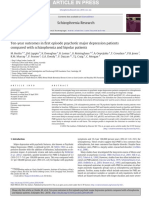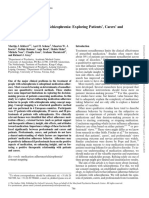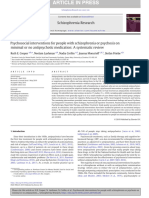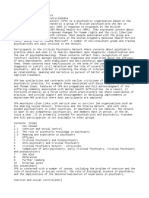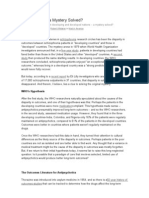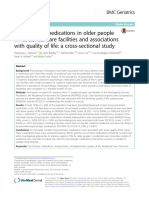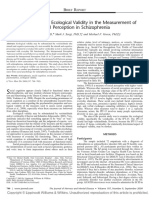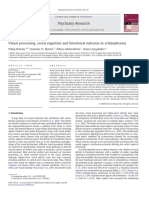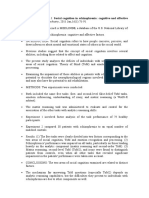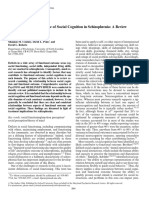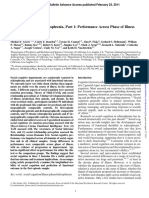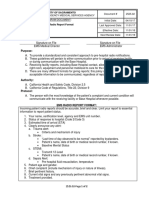Calidad de Vida 03
Calidad de Vida 03
Uploaded by
RosarioBengocheaSecoCopyright:
Available Formats
Calidad de Vida 03
Calidad de Vida 03
Uploaded by
RosarioBengocheaSecoCopyright
Available Formats
Share this document
Did you find this document useful?
Is this content inappropriate?
Copyright:
Available Formats
Calidad de Vida 03
Calidad de Vida 03
Uploaded by
RosarioBengocheaSecoCopyright:
Available Formats
ORIGINAL ARTICLES
Adherence to Medication and Quality of Life in People
With Schizophrenia
Results of a European Multicenter Study
Bernd Puschner, PhD,* Anja Born, Dipl-Psych, Anne Giebler, Dipl-Psych, Hedda Helm, Dipl-Psych,
Morven Leese, PhD, Jonathan P. Bindman, MRCPsych, Richard J. Gray, PhD, Aart Schene, MD,
Martijn Kikkert, MSc, Lorenzo Burti, MD, Giovanna Marrella, ClinPsy,
and Thomas Becker, MD*
Abstract: Quality of life is often severely impaired in people with
schizophrenia, and adherence to antipsychotic medication has been
consistently found to be low in this population. Although there is a
considerable amount of evidence on these two variables in schizophrenia research, there is only limited knowledge on how they relate
to one another. The aim of this study is to develop a meaningful
model of the relationship between quality of life and adherence that
includes mediating variables. A multicenter randomized controlled
trial recruited 409 subjects in London, Verona, Amsterdam, and
Leipzig. Baseline interviews obtained data on adherence, quality of
life, and other variables. We used graphical modeling to investigate
the relationships between the variables. No direct relation could be
discerned between subjective quality of life and adherence to medication. Mediating variables, most importantly symptomatic impairment, global functioning, and medication side effects, were identified by the model. It can be concluded that, when aiming at the
improvement of quality of life in people with schizophrenia, variables other than adherence, i.e., symptomatic impairment, global
functioning, and medication side effects, should be targeted.
Key Words: Schizophrenia, adherence, medication, quality of
life, graphical model.
(J Nerv Ment Dis 2006;194: 746 752)
*Department of Psychiatry II, Ulm University, Germany; Department of
Psychiatry, Leipzig University, Germany; Health Services Research
Department, Institute of Psychiatry, Kings College, London, United
Kingdom; Department of Psychiatry, Academic Medical Center, Amsterdam, The Netherlands; and Department of Medicine and Public
Health, Verona University, Verona, Italy.
The study was funded by a grant from the Quality of Life and Management
of Living Resources Program of the European Union (QLG4-CT-200101734).
Send reprint requests to Bernd Puschner, PhD, Department of Psychiatry II,
Ulm University, Ludwig-Heilmeyer-Str. 2, 89821 Gunzburg, Germany.
Copyright 2006 by Lippincott Williams & Wilkins
ISSN: 0022-3018/06/19410-0746
DOI: 10.1097/01.nmd.0000243082.75008.e7
746
chizophrenia can be regarded as a burden on the quality
of life (Gee et al., 2003). In recent years, quality of life
(QoL) has become a central outcome criterion in research on
severe mental illness. QoL is a complex and multidimensional construct pertaining to a persons perception of his or
her life situation in the context of a given cultures value
system relating to goals, expectations, and interests (WHOQOL
Group, 1998). Different dimensions of QoL are important in
everyday life, including physical and mental health, degree of
independence, social relationships, and characteristics of the
environment. Compared with healthy subjects, people suffering from schizophrenia have been found to display substantially lower levels of QoL (Carlsson et al., 2002; Reine et al.,
2003; Zissi et al., 1998).
Adherence to medication has been defined as the degree
to which patient behavior corresponds to medical advice
(Haynes, 1979). Nonadherence includes a range of different
behaviors and motives, e.g., total rejection of pharmacological treatment, occasionally forgetting or neglecting to take
medication (partial adherence), or misunderstanding of prescribed dosage and rate. While the efficacy of antipsychotic
medication in the treatment of schizophrenia has been extensively substantiated, nonadherence occurs frequently. About
50% of patients with schizophrenia do not take their medication as prescribed (Fenton et al., 1997; Lacro et al., 2002).
Furthermore, about 30% to 50% of patients change dose and
rate of medication without consulting a clinician after hospital discharge (Hornung et al., 1998; Verdoux et al., 2000).
A few authors have examined the relationship between
QoL and adherence to medication. Coldham et al. (2002)
found that nonadherent subjects suffering from first episode psychoses exhibited a poorer QoL than adherent subjects. Also, a recent literature review suggested that nonadherence might account for reduced QoL (Baloush-Kleinman
et al., 2002).
There are some hints as to factors that might affect this
relationship. Since QoL has been shown to relate substantially to the number of psychotic exacerbations, nonadherent
patients have a much higher risk of relapse than those who
take their medication as prescribed (75% vs. 25%), and
The Journal of Nervous and Mental Disease Volume 194, Number 10, October 2006
The Journal of Nervous and Mental Disease Volume 194, Number 10, October 2006
relapse in turn substantially decreases QoL (Perkins and
Repper, 1999). However, direction of this effect is unclear
since it could also be that frequent relapses and rehospitalizations lead to a decrease in QoL (Lacro et al., 2002), and
then patients stop or reduce taking medication.
Presence of intolerable side effects negatively affects
QoL (Cortese et al., 1998). Adverse effects are associated
with poor social functioning and reduction in QoL, possibly
resulting in patient nonadherence (Coffey, 1999; Perkins and
Repper, 1999). Conversely, high adherence might indirectly
improve QoL since adherence in general improves level of
functioning, which then positively affects QoL (Dolder et al.,
2003; Lacro et al., 2002).
Although QoL and adherence to medication in people
with schizophrenia have both been studied intensively, little
is known about how they relate to one another. By using data
from a large community sample of patients with schizophrenia in four European countries (Quality of Life following
Adherence Therapy for People Disabled by Schizophrenia
and their Carers QUATRO study), we will explore the following research questions:
(1) Is there a direct relationship between adherence to
medication and QoL?
(2) What is the role of mediating variables in the
relationship between adherence to medication and QoL?
Despite substantial cross-national differences in mental
health service provision, there has been a broad trend in
Western European countries toward a community-based
model of mental health care (Becker and Vazquez-Barquero,
2001). Strengths of well-conducted multisite cross-national
studies in psychiatric services research include (1) the development and refinement of internationally applicable research
instruments, (2) results from large patient samples that are
more widely generalizable than those from national studies,
(3) an increase of our understanding of health care systems,
and (4) the opportunity to generate hypotheses and improve
the understanding of cross-national variation. The QUATRO
study builds on the previous successful collaboration of the
research consortium in the EPSILON study, which produced
standardized scales in five EU languages in domains including QoL, mental health service costs, and service user needs
(cf. Thornicroft et al., 2000). Hence, while patients and
mental health services at QUATRO participating sites differ
in a number of aspects including language and service provision (Beecham and Munizza, 2000), the instruments applied have been shown to be useful and valid for the assessment of mental health processes and outcomes across sites.
METHODS
Participants
Baseline data from the QUATRO study, a randomized
controlled trial assessing the efficacy of Adherence Therapy
in people with schizophrenia at four participating sites in
London (United Kingdom), Amsterdam (The Netherlands),
Verona (Italy), and Leipzig (Germany), were used. For this
study, participants were recruited during 2002 from patients
under the care of psychiatric services in each of the four study
2006 Lippincott Williams & Wilkins
Adherence and QoL in Schizophrenia
sites. Inclusion criteria were clinical diagnosis of schizophrenia, patient in need of continuing antipsychotic medication
for at least the year following baseline, and evidence of
clinical instability in the year before baseline (defined as a
hospital admission, or a change in the type and/or dose of
medication). Exclusion criteria were presence of moderate or
severe mental handicap (learning disability), organic brain
disorders, treatment by forensic psychiatric services, alcohol
or drug dependence, insufficient ability to speak the language
of host country, or lack of capacity to give valid consent to
participation.
Mental Health Service Provision at Sites
London
Specialist mental health services in Croydon for the
general adult population include 80 acute adult psychiatric
beds for the 330,000 population. For the provision of community mental health services, the borough is divided into
three localities, each serving a population of about 100,000.
Each of these three localities contains two or three general
adult community mental health teams, which typically include community psychiatric nurses, an attached social
worker, an attached occupational therapist, a consultant psychiatrist, and a junior psychiatrist. There are four community
mental health centers for the whole borough of Croydon.
These function as community multidisciplinary team bases,
settings for outpatient and depot medication clinics, and
day-centers providing occupational therapy and psychotherapeutic groups. Social services and the private and voluntary
sectors also provide day-care places, work opportunities, and
pop-in services.
Amsterdam
The city (with a total population of 740,000 inhabitants) is divided into three mental health care regions. Each
region has had an integrated mental health care service since
1994. In these three services, mental hospital facilities, community mental health services and sheltered living accommodations are united. Each area has a special service for the
long-term mentally ill. This provides acute and nonacute
inpatient care, day treatment, and mobile teams. The principles of assertive community treatment with an active outreach
strategy are available. A 24-hour crisis service, a psychiatric
drop in service for acute assessments, public mental health
services, and addiction services are available for the whole city.
Verona
The city (330,000 inhabitants) is subdivided into three
areas, each served by a community psychiatric service providing a wide range of well-integrated hospital and community services to the adult resident population. These services
include 45 acute general-hospital psychiatric beds, three multipurpose community mental health centres, multidisciplinary
community teams, and community-based residential facilities
with various degrees of staff supervision. Standard treatment
is based on the principles of continuity of care and on specific
commitment to the most severe and long-term cases. Community mental health centers are the headquarters of commu-
747
Puschner et al.
The Journal of Nervous and Mental Disease Volume 194, Number 10, October 2006
nity teams and provide outpatient care for crisis intervention
and follow-up, day care, and psychosocial rehabilitation.
Community teams offer outreach interventions both for emergency calls and for ongoing care and support. A program run
in collaboration with a consumer group offers extra accommodations, vocational rehab, work slots, social activities, and
mutual help.
Leipzig
For the citys 495,000 inhabitants, inpatient psychiatric
care is provided by a psychiatric hospital (with specialist old
age and addiction services) on the outskirts of the city, by the
University department, and by another psychiatric hospital
outside of the city. While outpatient services including psychotherapy are provided by specialized psychiatrists and
psychotherapists, there is limited provision of a range of
residential services and work rehabilitation services.
Assessment and Measures
The following information was obtained by the following instruments:
Socioeconomic Status and Service Use (Including
Length of Psychiatric Hospital Stays During the
Previous Year)
The European version of the Client Sociodemographic
and Service Receipt Inventory (CSSRI-EU; Chisholm et al.,
2000).
Adherence to Neuroleptic Medication
The Medication Adherence Questionnaire (MAQ;
Morisky et al., 1986) is a 4-item self-report questionnaire
assessing medication-taking behavior: forgetting the drugs,
carelessness, stopping the drug when feeling better, and
stopping the drug when feeling worse. The items produce a
total score ranging from 0 (all items rated with yes) to 4 (all
items rated with no), with higher scores indicating higher
adherence.
QoL
The Manchester Short Assessment of Quality of Life
(MANSA; Priebe et al., 1999) is a brief questionnaire focusing on satisfaction with life as a whole and with 14 specific
life domains (e.g., employment, financial situation, family
relationships, accommodation, sexuality, mental health, physical health). A high sum score (range, 17) is associated with
a high level of QoL. Published levels of validity and reliability are good (Priebe et al., 1999).
Illness Insight
The Schedule for the Assessment of Insight-Expanded
Version (SAI-E; David, 1990; Kemp et al., 1998) is a 14-item
instrument measuring three separate dimensions of insight:
treatment compliance, awareness of illness, and relabeling of
symptoms. With the expanded version further items on
awareness of change in mental functioning, need for treatment and psychosocial consequences of the illness are provided. Higher scores on this measures indicate higher level of
insight.
748
Attitude Toward Neuroleptic Medication
The Drug Attitude Inventory (DAI-10; Hogan et al.,
1983) consists of 10 yes/no statements reflecting patients
experiences, attitudes and beliefs about medication. The DAI-10
is a brief form of DAI-30 and this self-report scale was developed to assess how the subjective attitude toward neuroleptic
medication of people with schizophrenia may affect compliance
with treatment. The scale has good reliability and validity
(Hogan et al., 1983).
Side Effects
The Liverpool University Neuroleptic Side Effect Rating Scale (LUNSERS; Day et al., 1995) is a 51-item scale
measuring unwanted side effects during the previous month
that produces a total score where a low score indicates fewer
reported side effects.
Symptoms
The Brief Psychiatric Rating Scale-Expanded (BPRS-E;
Lukoff et al., 1986; Ventura et al., 1993) is a widely used
observer-rated scale consisting of 24 items. The BPRS is a
sensitive and effective measure of psychopathology and treatment related symptom change (Dingemans et al., 1995).
Functioning
The Global Assessment of Functioning (GAF) scale
(American Psychiatric Association, 1987) is rater-assessed
and has good levels of reliability and validity (Jones et al.,
1995). Overall level of symptomatology and social function
in the previous month are evaluated on a continuous scale
from 0 to 100, with higher values indicating higher levels of
functioning.
All interviews were carried out by a research worker
trained in the application of the study instruments.
Procedures
Graphical modeling (Edwards, 2000) using the software MIM (http://www.hypergraph.dk/) was used to ascertain relevant structures in the correlation matrix of QoL,
adherence to medication, and the covariates: attitude toward
neuroleptic medication, illness insight, side effects, psychopathology, functioning, and length of psychiatric inpatient
stays (in days) during the previous year (LOS). MIM yields a
graphical depiction of a given data set in which a graph is
based on a model of conditional independence. Variables are
considered conditionally independent when the partial correlation between them equals 0, in which case no link in the
graph is displayed. Model selection was computed using a
backward stepwise selection procedure (using two critical
levels for statistical significance, 0.05 and 0.01). Furthermore, cross-validation was carried out by splitting the sample
in two at random and running the models on both halves.
RESULTS
Sample
Of 1218 patients reported by clinicians as meeting
inclusion criteria, 409 participated at baseline. Reasons for
not participating were not meeting criteria for schizophrenia
2006 Lippincott Williams & Wilkins
The Journal of Nervous and Mental Disease Volume 194, Number 10, October 2006
Correlation Matrix of Model Variables
TABLE 1. Sociodemographic Characteristics (N 409)
Characteristic
As can be seen in Table 3, correlation between adherence and QoL was rather low. Furthermore, adherence moderately correlated with attitude to medication and to psychopathology (negatively), while subjective QoL moderately
correlated with all included variables (positively: attitude
toward medication, functioning; negatively: psychopathology, side effects) apart from illness insight and LOS.
N (%)
Male
Married or cohabiting
White European
Education: primary/secondary only
Living alone
Accommodation: owned or rented
Employment: paid or self employed
245 (60%)
47 (12%)
310 (76%)
271 (67%)
165 (40%)
314 (77%)
59 (15%)
Identifying Relevant Relationships Via
Graphical Modeling
First, a graphical model (backward selection) with
critical level .05 was fitted. This model proved overly
complex, i.e., few variables were eliminated (note however
that the direct path between QoL and adherence was already
deleted in this first model). Thus, a stricter criterion for model
selection was applied (critical level .01; model parameters
in Table 4). Cross-validation (via carrying out the computation on two random subsamples; results not shown) yielded
slightly different model solutions, but in neither case was
there a direct path between QoL and adherence. The resulting
graphical representation of the second model fitted to the
complete data set is displayed in Figure 1.
Focusing on pathways with not more than two intermediate variables between adherence and QoL, two pathways
became evident (relevant fitted partial correlation coefficients
have been inserted, cf. Table 4): (a) intermediate variables
psychopathology and side effects (solid bold lines); (b) intermediate variables psychopathology and level of functioning
(solid interrupted lines).
TABLE 2. Variables in Model
Variable
Adherence
Attitude
Insight
Side effects
QoL
Psychopathology
Functioning
LOSa
a
Adherence and QoL in Schizophrenia
Scale
Mean
SD
MAQ
DAI
SAI-E
LUNSERS
MANSA
BPRS
GAF
CSSRI
2.97
6.42
15.58
27.67
4.45
45.17
50.29
27.92
1.22
2.04
6.52
21.43
.98
13.02
13.92
60.41
396
382
284
401
408
406
407
409
Psychiatric hospital days during 1 year prior to assessment.
(N 52), refusal to participate (N 366), not meeting other
inclusion criteria (N 249), or other reasons (N 142).
Socioeconomic status characteristics of the sample
were quite typical for a population treated for schizophrenia.
Participants mean age was 41.5 years (SD 11.5). As can
be seen in Table 1, little over half of participants were male,
relatively few were married or cohabiting, and three quarters
were white, while almost half lived alone, usually in owned
or rented accommodation, and only about 15% were in paid
employment.
DISCUSSION
The relationship between adherence to neuroleptic medication and subjective QoL was examined in a large multinational European sample of people with schizophrenia. This
study fills a substantial gap since without evidence regarding
this relationship, the relevance of adherence for the ultimate
goal of treatment, i.e., the QoL of the target population, remains
unsubstantiated.
The hypothesis that a direct relationship between adherence and QoL would be found had to be rejected. Even
though correlation (r .01) between these two variables
reached statistical significance (mainly because of large sample size, N 409), it was not retained in the graphical
Variables Included in Model
Table 2 gives an overview of the variables to be
included in the model. Participants rated themselves as relatively highly adherent on the MAQ. Subjective QoL on the
MANSA was rather low. As measured by the BPRS and
GAF, participants were moderately severely symptomatic
and disabled. On average, they had spent about a month in the
year prior to baseline as inpatients.
TABLE 3. Correlations (Pearson) of Model Variablesa
Attitude
Insight
Side effects
QoL
Psychopathology
Functioning
LOS
Adherence
Attitude
Insight
Side Effects
QoL
Psychopathology
Functioning
.133**
.071
.084
.103*
.205**
.063
.079
.168**
.140**
.206**
.191**
.305**
.099*
.201**
.052
.208**
.321**
.065
.216**
.341**
.037
.082
.262**
.234**
.053
.419**
.028
.078
*p 0.05; **p 0.01.
a
N 409 (missings imputed by site).
2006 Lippincott Williams & Wilkins
749
The Journal of Nervous and Mental Disease Volume 194, Number 10, October 2006
Puschner et al.
TABLE 4. Fitted Partial Correlation Parameters (Critical Level .01)a
Attitude
Insight
Side effects
QoL
Psychopathology
Functioning
LOS
a
Adherence
Attitude
Insight
Side Effects
QoL
Psychopathology
Functioning
.172
.143
.240
.269
.179
.227
.191
.376
.085
.162
.346
N 409 (missings imputed by site).
models, not even in the one with a rather lenient criterion for
elimination of relationships between variables.
A rather strict (critical level for backward selection
.01) graphical model showed that psychopathology, level of
functioning, and experience of unwanted side effects contributed most to the relationship between adherence and QoL,
while other scrutinized variables (illness insight, attitude to
medication, and LOS) were hardly relevant.
Furthermore, in this model, adherence was directly
related only to psychopathology, which contradicts conceptions of adherence as determined by numerous patient-related,
illness-related, and treatment-related factors (Bebbington, 1995;
Lacro et al., 2002; Rettenbacher et al., 2004). Moreover, this
finding indicates that medication, when taken as prescribed, is
positively associated with symptomatic impairment, but that
other domains remain unaffected, which substantiates skepticism as to an all-embracing effect of neuroleptic medication
(Huxley et al., 2000; Lauriello et al., 2003).
Conversely, in line with its complex nature, QoL
showed a number of relations to other variables in the model.
First, the finding of a relation between QoL and medication
side effects is in concordance with previous research (Hofer
FIGURE 1. Graphical model of the relation between quality
of life and adherence including covariates in people with
schizophrenia.
750
et al., 2004). Second, the finding of a relation between QoL
and attitude toward taking neuroleptic medication is generally
in line with recommendations to consider patients subjective
experiences of antipsychotics (Hellewell, 2002). Third, as in
our model, previous research has also pointed toward a substantial relation of QoL with level of functioning (Lambert
and Naber, 2004; Norman et al., 2000).
Considering the question of mediated relation between
adherence and QoL, two obvious pathways emerged that
suggest the following interpretation. First, the higher participants rated adherence, the lower their psychopathology, the
less often unwanted side effects were experienced, and consequently the higher QoL. This finding is partly in concordance with Cortese et al. (1998), who pointed to an impact of
side effects on QoL resulting in low adherence. However,
Cortese et al. (1998) argued that level of functioning plays an
important role in this process which was not found in our
model. Second, the higher participants rated adherence, the
lower their psychopathology, the higher their general level of
functioning, and consequently the higher QoL. This pathway
is in line with previous research (Dolder et al., 2003; Lacro et
al., 2002) which, however, only indicated the mediating role
of psychopathology, but not of level of functioning.
The model emerging from this study seems compatible
with adherent patients being relatively well both in terms of
psychopathology and low levels of side effects, while nonadherent patients are disadvantaged in both domains, with
insight and attitude playing secondary roles. Given the central
role of psychopathology as a mediator between adherence
and other outcome measures, a traditional interpretation of
these findings would be that patients with schizophrenia
adhere to neuroleptic medication provided these have a beneficial effect on their pivotal symptomatic impairment. Only
then can an effect on other softer outcome criteria, e.g.,
QoL, be reasonably expected.
Several limitations of this study should be mentioned.
First, measurement of adherence was patient-rated, and selfratings of adherence tend to overestimate actual adherence.
Second, even though our model included a large number of
variables, other factors might affect the relationship between
adherence and QoL, e.g., relapse, type/dosage of neuroleptic
medication, and/or adequacy of prescription. Third, even
though a large sample was recruited, participants were mostly
outpatients with a long duration of illness. Consequently,
2006 Lippincott Williams & Wilkins
The Journal of Nervous and Mental Disease Volume 194, Number 10, October 2006
results should not be generalized to other patient groups.
Fourth, the proposed model leaves a number of questions
unanswered, especially those pertaining to direction of effect
since it is also possible thatvia the specified pathways
QoL affects adherence.
Further research should take into account that improving adherence to neuroleptic medication might not directly
result in better QoL in people with schizophrenia. It might be
especially fruitful to add a longitudinal perspective to the
model arrived at in this study to ascertain the effect of time
and direction of effects in the complex relationship between
adherence and QoL.
In conclusion, the results of this European multicenter
study show that adherence to neuroleptic medication is only
indirectly linked to QoL in people with schizophrenia. When
aiming at the improvement of QoL in people with schizophrenia, other variables than adherence should be targeted,
even though mediated effects of adherence on QoL, e.g., via
symptomatic impairment, emerged.
ACKNOWLEDGMENTS
This study is part of a multicenter collaborative study
between the Health Services Research Department, Institute
of Psychiatry, Kings College London; the Department of
Medicine and Public Health, Section of Psychiatry, Verona
University, Italy; the Department of Psychiatry, Leipzig University, Germany; and the Department of Psychiatry, Academic Medical Center, Amsterdam University, The Netherlands. The funders had no role in the design and conduct of
the study, the collection, management, analysis, and interpretation of the data, or the preparation, review, or approval
of the manuscript. The first author had full access to all of the
data in the study and takes responsibility for the integrity of
the data and the accuracy of the data analysis. We also wish
to acknowledge the contributions of the patients, carers, and
staff who have taken part in the study.
REFERENCES
American Psychiatric Association (1987) Diagnostic and Statistical Manual
(3rd ed, Revised). Washington (DC): American Psychiatric Association.
Baloush-Kleinman V, Poyurovsky M, Koren D, Schneidman M, Weizman
A, Shnitt D (2002) Adherence to antipsychotic medication in schizophrenia patients. Harefuah. 141:10421049.
Bebbington P (1995) The content and context of compliance. Int Clin
Psychopharmacol. 9:4150.
Becker T, Vazquez-Barquero JL (2001) The European perspective of psychiatric reform. Acta Psychiatr Scand. (suppl 104):8 14.
Beecham J, Munizza C (2000) Introduction: Assessing mental health in
Europe. Acta Psychiatr Scand. 405:57.
Carlsson I, Frederiksen SO, Gottfries CG (2002) Quality of life and standard
of living in a randomly selected group of psychiatrically disabled people
in Sweden 2 years after a psychiatry reform. Eur Psychiatry. 17:179 187.
Chisholm D, Knapp M, Knudsen HC, Amaddeo F, Gaite L, van Wijngaarden
B, et al. (2000) Client Sociodemographic and Service Receipt Inventory
European version. Br J Psychiatry. 177:28 33.
Coffey M (1999) Psychosis and medication: Strategies for improving adherence. Br J Nurs. 8:225230.
Coldham EL, Addington J, Addington D (2002) Medication adherence of
individuals with a first episode of psychosis. Acta Psychiatr Scand.
106:286 290.
Cortese L, Pourcher-Bouchard E, Williams R (1998) Assessment and management of antipsychotic-induced adverse events. Can J Psychiatry. 43:
1520.
2006 Lippincott Williams & Wilkins
Adherence and QoL in Schizophrenia
David A (1990) Schedule for assessment of insight into psychosis. Br
J Psychiatry. 156:798 803.
Day JC, Wood G, Dewey M, Bentall RP (1995) Liverpool University
Neuroleptic Side Effect Rating Scale. Br J Psychiatry. 166:650 653.
Dingemans P, Linszen DH, Lenior ME, Smeets RM (1995) Component
structure of the expanded Brief Psychiatric Rating Scale (BPRS-E).
Psychopharmacology. 122:263267.
Dolder C, Lacro J, Leckband S, Jeste D (2003) Interventions to improve
antipsychotic medication adherence: Review of recent literature. J Clin
Pharmacol. 23:389 399.
Edwards D (2000) Introduction to Graphical Modelling (2nd ed). New York:
Springer.
Fenton WS, Blyler CR, Hummer M (1997) Determinants of medication
compliance in schizophrenia: Empirical and clinical findings. Schizophr
Bull. 23:637 651.
Gee L, Pearce E, Jackson M (2003) Quality of life in schizophrenia: A
grounded theory approach. Health Qual Life Outcomes. 1:113.
Haynes RB (1979) Introduction. In RB Haynes, DW Taylor, DL Sacket
(Eds), Compliance in Health Care (pp 110). Baltimore: John Hopkins
Press.
Hellewell JS (2002) Patients subjective experiences of antipsychotics:
Clinical relevance. CNS Drugs. 16:457 471.
Hofer A, Kemmler G, Eder U, Edlinger M, Hummer M, Fleischhacker W
(2004) Quality of life in schizophrenia: The impact of psychopathology,
attitude toward medication and side effects. J Clin Psychiatry. 65:932
939.
Hogan TP, Awad AG, Eastwood R (1983) A self-report scale predictive of
drug compliance in schizophrenics: Reliability and discriminative validity.
Psychol Med. 13:177183.
Hornung WP, Klingberg S, Feldmann R, Schonauer K, Schulze Monking H
(1998) Collaboration with drug treatment by schizophrenic patients with
and without psychoeducational training: Results of a 1-year follow-up.
Acta Psychiatr Scand. 97:213219.
Huxley N, Rendall M, Sederer L (2000) Psychosocial treatments in schizophrenia: A review of the past 20 years. J Nerv Ment Dis. 188:187201.
Jones S, Thornicroft G, Coffey M, Dunn G (1995) A brief mental health
outcome scale-reliability and validity of the Global Assessment of Functioning (GAF). Br J Psychiatry. 166:654 659.
Kemp R, Kirov G, Everitt B, Hayward P, David A (1998) Randomised
controlled trial of compliance therapy: 18-month follow-up. Br J Psychiatry. 172:413 419.
Lacro JP, Dunn LB, Dolder CR, Leckband SG, Jeste DV (2002) Prevalence
of and risk factors for medication nonadherence in patients with schizophrenia: A comprehensive review of recent literature. J Clin Psychiatry.
63:892909.
Lambert M, Naber D (2004) Current issues in schizophrenia: Overview of
patient acceptability, functioning capacity and quality of life. CNS Drugs.
18(suppl 2):517.
Lauriello J, Lenroot R, Bustillo J (2003) Maximizing the synergy between
pharmacotherapy and psychosocial therapies for schizophrenia. Psychiatr
Clin North Am. 26:191211.
Lukoff D, Liberman RP, Nuechterlein KH (1986) Symptom monitoring in
the rehabilitation of schizophrenic patients. Schizophr Bull. 12:578
602.
Morisky DE, Green LW, Levine DM (1986) Concurrent and predictive validity
of a self-reported measure of medication adherence. Med Care. 24:6774.
Norman R, Malla A, McLean T, Voruganti L, Cortese L, McIntosh E, Cheng
S, Rickwood A (2000) The relationship of symptoms and level of functioning in schizophrenia to general wellbeing and the Quality of Life
Scale. Acta Psychiatr Scand. 102:303309.
Perkins R, Repper JM (1999) Compliance or informed choice. J Ment
Health. 8:117129.
Priebe S, Huxley P, Knight S, Evans S (1999) Application of the Manchester
Short Assessment of Quality of Life (MANSA). Int J Soc Psychiatry.
45:712.
Reine G, Lancon C, DiTucci S, Sapin C, Auquier P (2003) Depression and
subjective quality of life in chronic phase schizophrenic patients. Acta
Psychiatr Scand. 108:297303.
Rettenbacher MA, Hofer A, Eder U, Hummer M, Kemmler G, Weiss EM,
751
Puschner et al.
The Journal of Nervous and Mental Disease Volume 194, Number 10, October 2006
Fleischhacker WW (2004) Compliance in schizophrenia: Psychopathology, side effects and patients attitudes toward the illness and medication.
J Clin Psychiatry. 65:12111218.
Thornicroft G, Becker T, Knapp M, Knudsen HC, Schene A, Tansella M,
Vazquez-Barquero JL (2000) Reliable outcome measures for mental
health service research in five European countries: The EPSILON study.
Br J Psychiatry. 177:154.
Ventura J, Green M, Schaner A, Liberman R (1993) Training and quality
assurance with the Brief Psychiatric Rating Scale: The drift busters. Int
J Methods Psychiatr Res. 3:221244.
752
Verdoux H, Lengronne J, Liraud F, Gonzales B, Assens F, Abalan F,
van Os J (2000) Medication adherence in psychosis: predictors and
impact on outcome: A 2-year follow-up of first-admitted patients. Acta
Psychiatr Scand. 102:203210.
WHOQOL group (1998) The World Health Organization quality of life
assessment (WHOQOL): Development and general psychometric properties. Soc Sci Med. 46:1569 1585.
Zissi A, Barry MM, Cochrane R (1998) A mediational model of quality of
life for individuals with severe mental health problems. Psychol Med.
28:12211230.
2006 Lippincott Williams & Wilkins
You might also like
- Case Study For Dual DiagnosisDocument12 pagesCase Study For Dual DiagnosisDanelleHollenbeck0% (1)
- IEC TestDocument31 pagesIEC Testwazi nisa100% (1)
- Rahim 2Document69 pagesRahim 2ghoongru100% (1)
- Commercial Aerospace Coatings: Revised February 2020Document9 pagesCommercial Aerospace Coatings: Revised February 2020Jose Miguel Atehortua ArenasNo ratings yet
- Co-Existing Problems of Mental Health and Substance Misuse (Dual Diagnosis) : A Literature ReviewDocument74 pagesCo-Existing Problems of Mental Health and Substance Misuse (Dual Diagnosis) : A Literature ReviewPamela Cedeño Mendoza100% (1)
- Staff Perceptions of Substance Use Among Acute Psychiatry In-PatientsDocument6 pagesStaff Perceptions of Substance Use Among Acute Psychiatry In-PatientsPaula StroianNo ratings yet
- Land Olt 2011Document13 pagesLand Olt 2011Windy TiandiniNo ratings yet
- Guia EsquizoDocument8 pagesGuia EsquizoSeleccion PersonalNo ratings yet
- Social Aspects of The Quality of Life of Persons Suffering From SchizophreniaDocument11 pagesSocial Aspects of The Quality of Life of Persons Suffering From SchizophreniaFathur RNo ratings yet
- Ten-Year Outcomes in First Episode Psychotic Major Depression Patients Compared With Schizophrenia and Bipolar PatientsDocument6 pagesTen-Year Outcomes in First Episode Psychotic Major Depression Patients Compared With Schizophrenia and Bipolar PatientsSakuraKhaleesiNo ratings yet
- Hypothetical Case Study Physicians' Labelling of End-Of-Life Practices: ADocument7 pagesHypothetical Case Study Physicians' Labelling of End-Of-Life Practices: Apenikek603No ratings yet
- tmpE2CA TMPDocument5 pagestmpE2CA TMPFrontiersNo ratings yet
- BradshawDocument9 pagesBradshawFatur AkhiNo ratings yet
- Psychosocial Support Groups For Patients With Multidrug Resistant Tuberculosis Five Years of ExperienceDocument15 pagesPsychosocial Support Groups For Patients With Multidrug Resistant Tuberculosis Five Years of ExperienceLinh NguyenNo ratings yet
- Exploring Experiences of and Attitudes Towards Mental Illness and Disclosure Amongst Health Care Professionals A Qualitative StudyDocument8 pagesExploring Experiences of and Attitudes Towards Mental Illness and Disclosure Amongst Health Care Professionals A Qualitative StudyleticiaNo ratings yet
- jurnal inter 7Document9 pagesjurnal inter 7Rian SyahNo ratings yet
- Treating Drug Dependence With The Aid of Ibogaine: A Qualitative StudyDocument10 pagesTreating Drug Dependence With The Aid of Ibogaine: A Qualitative StudyeduardoschenbergNo ratings yet
- Good For QualitativeDocument9 pagesGood For QualitativeWassie TsehayNo ratings yet
- Running Head: Effects of Follow-Up Psychiatric Care 1Document20 pagesRunning Head: Effects of Follow-Up Psychiatric Care 1api-409577818No ratings yet
- Archives of Psychiatric Nursing: Lora Humphrey Beebe, Kathleen Smith, Chad PhillipsDocument6 pagesArchives of Psychiatric Nursing: Lora Humphrey Beebe, Kathleen Smith, Chad PhillipsArif IrpanNo ratings yet
- 2012 - VAN MECHELEN - Defining The Palliative Care Patient - A Systematic ReviewDocument59 pages2012 - VAN MECHELEN - Defining The Palliative Care Patient - A Systematic ReviewtatiayuharaNo ratings yet
- OutDocument9 pagesOutAsyifaRizkiNo ratings yet
- Cooper 2019Document16 pagesCooper 2019Lee HaeunNo ratings yet
- 10.1007@s11065 020 09443 7Document14 pages10.1007@s11065 020 09443 7José NettoNo ratings yet
- garety1994Document13 pagesgarety1994adithyaram630No ratings yet
- Current Practices, Experiences, and Views in Clinical HypnosisDocument43 pagesCurrent Practices, Experiences, and Views in Clinical HypnosisJoBPNo ratings yet
- Illicit Drug Use in Cluster Headache Patients and in The General Population: A Comparative Cross-Sectional SurveyDocument10 pagesIllicit Drug Use in Cluster Headache Patients and in The General Population: A Comparative Cross-Sectional SurveyRicky HerdiantoNo ratings yet
- Jurnal Psikiatri PDFDocument5 pagesJurnal Psikiatri PDFI Gusti Ngurah Agung Indra SuhartaNo ratings yet
- Stroke Article 1Document10 pagesStroke Article 1api-292843843No ratings yet
- The Practices Subspecialty Internists Counseling Smoking ExerciseDocument5 pagesThe Practices Subspecialty Internists Counseling Smoking ExerciseIlyichia HuttonNo ratings yet
- Personality Mental Health - 2010 - Petersen - A 2 Year Follow Up of Mentalization Oriented Group Therapy Following DayDocument8 pagesPersonality Mental Health - 2010 - Petersen - A 2 Year Follow Up of Mentalization Oriented Group Therapy Following DayTiago AntônioNo ratings yet
- Review of Related Literature of SchizophreniaDocument6 pagesReview of Related Literature of Schizophreniac5rqq644100% (1)
- Hasler 2015Document32 pagesHasler 2015Seplou7iNo ratings yet
- Version of Record:: ManuscriptDocument20 pagesVersion of Record:: ManuscriptChristiana TomescuNo ratings yet
- Critical Psychiatry NetworkDocument7 pagesCritical Psychiatry NetworkMikeyXkidNo ratings yet
- Inggris IntervensionDocument8 pagesInggris IntervensionNasrudin JamilNo ratings yet
- Unified Protocol For Transdiagnostic Treatment of Emotional Disorders. A Randomized Controlled TrialDocument13 pagesUnified Protocol For Transdiagnostic Treatment of Emotional Disorders. A Randomized Controlled TrialfanzefirlNo ratings yet
- Plos Medicine /Article/Crossref/I /Article/Tw Itter/Info /Article/Metrics/Inf Info:Doi/10.1371/J Patient Adher 1185260400000Document25 pagesPlos Medicine /Article/Crossref/I /Article/Tw Itter/Info /Article/Metrics/Inf Info:Doi/10.1371/J Patient Adher 1185260400000khattak_i89No ratings yet
- TB Tratamiento TempranoDocument9 pagesTB Tratamiento TempranoteretransproteNo ratings yet
- Tratamiento Del Trastorno Bipolar Resistente A TratamientoDocument27 pagesTratamiento Del Trastorno Bipolar Resistente A TratamientoLaura VargasNo ratings yet
- A Schizophrenia Mystery SolvedDocument3 pagesA Schizophrenia Mystery SolvedRoberto ScafidiNo ratings yet
- Harrison Et Al - 2018 - Psychotropic Medications in Older PeopleDocument8 pagesHarrison Et Al - 2018 - Psychotropic Medications in Older Peopleandrewbaker9990No ratings yet
- Kelly Difficult To Reach ODINDocument29 pagesKelly Difficult To Reach ODINHelen RodriguesNo ratings yet
- Levy Ehrenthal Etal Efficacy PT PDT 2014Document46 pagesLevy Ehrenthal Etal Efficacy PT PDT 2014Maria SilvérioNo ratings yet
- Revised Olu-ELR Does Patient Engagement Impact Relapse Outcomes - EditedDocument43 pagesRevised Olu-ELR Does Patient Engagement Impact Relapse Outcomes - Editedsamir morogaNo ratings yet
- Annals of General PsychiatryDocument9 pagesAnnals of General PsychiatryPutu Agus GrantikaNo ratings yet
- Long-Acting Antipsychotic Drugs For The Treatment of Schizophrenia: Use in Daily Practice From Naturalistic ObservationsDocument13 pagesLong-Acting Antipsychotic Drugs For The Treatment of Schizophrenia: Use in Daily Practice From Naturalistic ObservationsNurulAlviFauzianaNo ratings yet
- Is The Global Prevalence Rate of Adult Mental Illness Increasing - Systematic Review and Meta-Analysis - PreprintDocument25 pagesIs The Global Prevalence Rate of Adult Mental Illness Increasing - Systematic Review and Meta-Analysis - PreprintKshamaa HgNo ratings yet
- Antipsychotic Treatment A Systematic Literature Review and Meta Analysis of Qualitative StudiesDocument12 pagesAntipsychotic Treatment A Systematic Literature Review and Meta Analysis of Qualitative StudiesmafeNo ratings yet
- WFBP Guidelines PDFDocument66 pagesWFBP Guidelines PDFAnonymous fPQaCe8No ratings yet
- Drug Use and Ageing PaperDocument12 pagesDrug Use and Ageing PaperEdo Von CrnićNo ratings yet
- Acute Phase - Spain Shadow StudyDocument10 pagesAcute Phase - Spain Shadow Studysaxo001navyNo ratings yet
- Feijão-FreitasMelo2020 Article TreatmentAdherenceOfPatientsWiDocument20 pagesFeijão-FreitasMelo2020 Article TreatmentAdherenceOfPatientsWiAndrea Lopez FrankNo ratings yet
- Adiksi Prof PDF Bab 8Document28 pagesAdiksi Prof PDF Bab 8tito syahjihadNo ratings yet
- Macpherson 2016 The Relationship Between Clinical ADocument21 pagesMacpherson 2016 The Relationship Between Clinical Aantonio de diaNo ratings yet
- D Barriers To Improved Diabetes Management: Results of The Cross-National Diabetes Attitudes, Wishes and Needs (DAWN) StudyDocument13 pagesD Barriers To Improved Diabetes Management: Results of The Cross-National Diabetes Attitudes, Wishes and Needs (DAWN) StudyDanastri PrihantiniNo ratings yet
- Carousel Restricted AccessDocument12 pagesCarousel Restricted AccessJess BaerNo ratings yet
- Jurnal 5Document9 pagesJurnal 5raraNo ratings yet
- The Revised Illness Perception Questionnaire IPQ-RDocument17 pagesThe Revised Illness Perception Questionnaire IPQ-RgokhanNo ratings yet
- Why Do Some Individuals With Serious Mental Illness Refuse To Take Medication FinalDocument5 pagesWhy Do Some Individuals With Serious Mental Illness Refuse To Take Medication FinalMohamed OmerNo ratings yet
- Neuropsychiatry in UkDocument5 pagesNeuropsychiatry in UkKaram Ali ShahNo ratings yet
- Jurnal ReadinhDocument7 pagesJurnal ReadinhwindysiNo ratings yet
- ConnectednessDocument13 pagesConnectednessRosarioBengocheaSeco100% (1)
- Maintenance Guide PDFDocument2 pagesMaintenance Guide PDFRosarioBengocheaSecoNo ratings yet
- Early Warning SignsDocument1 pageEarly Warning SignsRosarioBengocheaSecoNo ratings yet
- ConnectednessDocument13 pagesConnectednessRosarioBengocheaSeco100% (1)
- Activities For Assessing and Developing ReadinessDocument17 pagesActivities For Assessing and Developing ReadinessRosarioBengocheaSecoNo ratings yet
- Vaskin 2009Document3 pagesVaskin 2009RosarioBengocheaSecoNo ratings yet
- Psychiatry Research: Philip Brittain, Dominic H. Ffytche, Allison Mckendrick, Simon SurguladzeDocument6 pagesPsychiatry Research: Philip Brittain, Dominic H. Ffytche, Allison Mckendrick, Simon SurguladzeRosarioBengocheaSecoNo ratings yet
- Bell 2010Document8 pagesBell 2010RosarioBengocheaSecoNo ratings yet
- Ziv 2011Document2 pagesZiv 2011RosarioBengocheaSecoNo ratings yet
- Social Perception and Social Skill in SchizophreniaDocument12 pagesSocial Perception and Social Skill in SchizophreniaRosarioBengocheaSecoNo ratings yet
- Couture 2006Document20 pagesCouture 2006RosarioBengocheaSecoNo ratings yet
- Green 2011ADocument11 pagesGreen 2011ARosarioBengocheaSecoNo ratings yet
- Social Cognition in Schizophrenia, Part 2: 12-Month Stability and Prediction of Functional Outcome in First-Episode PatientsDocument8 pagesSocial Cognition in Schizophrenia, Part 2: 12-Month Stability and Prediction of Functional Outcome in First-Episode PatientsRosarioBengocheaSecoNo ratings yet
- Roberts 2009Document7 pagesRoberts 2009RosarioBengocheaSecoNo ratings yet
- Homeopathy For The Control of Plant PathogensDocument6 pagesHomeopathy For The Control of Plant PathogensFrancis ParthenicumNo ratings yet
- Tyson ComplaintDocument64 pagesTyson Complaintdave_jamieson1222No ratings yet
- School of Chemistry SOP For Operation of Vacuum Pumps and Evacuated Apparatus V18.04Document3 pagesSchool of Chemistry SOP For Operation of Vacuum Pumps and Evacuated Apparatus V18.04Anand HSNo ratings yet
- Oecd - Edu.imep, DSD Eag Uoe Fin@Df Uoe Fin Source GV PR Ndom, 1.0, Filtered, 2024!01!03 16-22-17Document21 pagesOecd - Edu.imep, DSD Eag Uoe Fin@Df Uoe Fin Source GV PR Ndom, 1.0, Filtered, 2024!01!03 16-22-17Emilia InfanteNo ratings yet
- PP-2525 EMS Radio Report FormatDocument2 pagesPP-2525 EMS Radio Report FormatNunuy NuriahNo ratings yet
- Sunflower 2Document20 pagesSunflower 2Aastha DubeyNo ratings yet
- D 7979 - 15e1Document18 pagesD 7979 - 15e1asmaNo ratings yet
- Service Manual: Suburban Water HeatersDocument26 pagesService Manual: Suburban Water HeatersTenny SupNo ratings yet
- Compressors and Compressed Air SystemsDocument24 pagesCompressors and Compressed Air SystemsjimmyshaNo ratings yet
- ETAG N°032: Guideline For European Technical ApprovalDocument93 pagesETAG N°032: Guideline For European Technical ApprovalcongtubatdaNo ratings yet
- WWW Lmnoeng ComDocument4 pagesWWW Lmnoeng ComjhdmssNo ratings yet
- Second Terminal Examination, 2017: BiologyDocument2 pagesSecond Terminal Examination, 2017: BiologysnehNo ratings yet
- Technology Developers, Inc. v. Court of Appeals, 193 SCRA 147, G.R. No. 94759, January 21, 1991Document8 pagesTechnology Developers, Inc. v. Court of Appeals, 193 SCRA 147, G.R. No. 94759, January 21, 1991Mayrll SantosNo ratings yet
- Breatehr Valve ManualDocument21 pagesBreatehr Valve ManualChaitanya Sai TNo ratings yet
- 1 Brochure WJH Program FinalDocument16 pages1 Brochure WJH Program FinalsusyqarmonNo ratings yet
- P$IDs Development ProcedureDocument147 pagesP$IDs Development ProcedureChems Eddine Mohamed FrahtiaNo ratings yet
- Selecting Salespeople: Prepared By: Brian RutherfordDocument15 pagesSelecting Salespeople: Prepared By: Brian RutherfordJivaansha SinhaNo ratings yet
- Scarlet Morillo - PDF MicrobiologistDocument3 pagesScarlet Morillo - PDF MicrobiologistStarlin MorilloNo ratings yet
- Term Paper On Absenteeism PDFDocument7 pagesTerm Paper On Absenteeism PDFaivie pearlNo ratings yet
- 5 Key Performance Indicators (KPI's) For MaintenanceDocument1 page5 Key Performance Indicators (KPI's) For MaintenanceEyoh EffiongNo ratings yet
- Learning Styles: Taught With Methods and Approaches Responsive To Their Learning Styles"Document12 pagesLearning Styles: Taught With Methods and Approaches Responsive To Their Learning Styles"Hariesz HorushiNo ratings yet
- D7050 Addressable Photoelectric Smoke and Smoke Heat Detector HeadsDocument3 pagesD7050 Addressable Photoelectric Smoke and Smoke Heat Detector HeadsBrillit RuizNo ratings yet
- Thermal Comfort and The Heat Stress IndicesDocument11 pagesThermal Comfort and The Heat Stress IndicestemterNo ratings yet
- Department of Labor: WAGE and HOUR DIVISI V AVENUE DENTAL CARE 2006LCA00029 (JUN 28 2007) 192343 CADEC SDDocument27 pagesDepartment of Labor: WAGE and HOUR DIVISI V AVENUE DENTAL CARE 2006LCA00029 (JUN 28 2007) 192343 CADEC SDUSA_DepartmentOfLabor0% (1)
- Priority Sector LendingDocument4 pagesPriority Sector LendingStan leeNo ratings yet
- DEPED/DECS Form 137Document3 pagesDEPED/DECS Form 137Rhonnel Manatad Alburo100% (1)
- Branches of ChemistryDocument9 pagesBranches of Chemistryabdulrehmanqadir001No ratings yet









